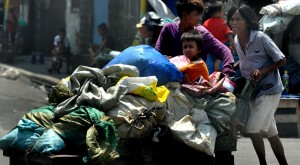Palace banners decline in poverty incidence amid slight increase in self-rated poverty
MANILA, Philippines—While a recent survey showed a slight increase in the number of Filipino families in Metro Manila and the rest of Luzon who consider themselves poor, Malacañang on Monday pointed out that government statistics present an actual decline in the country’s poverty incidence.
“We’d like to share with you the poverty incidence survey that the government—through the PSA (Philippine Statistics Authority)—what is called the Annual Poverty [Indicator] Survey or APIS where there’s a drop of three points from last year to this year. That means 2.5 million families are out of poverty,” Presidential Spokesperson Edwin Lacierda said during a televised briefing.
Communications Secretary Herminio “Sonny” Coloma Jr. also explained in a statement that the Family Income and Expenditure Survey (FIES) of the PSA showed that the poverty incidence dropped to 24.9 percent in the first semester of 2013 from 27.9 percent in the same period in 2012.
“The same FIES also showed subsistence incidence or the proportion of extremely poor Filipino individuals who could not afford to meet basic food requirements, also declined during the period from 13.4 percent in 2012 to 10.7 percent in 2013,” he said.
Lacierda said that while poverty incidence went down by only 0.2 points during the years of 2006 to 2009 and by only 0.7 points from 2009 to 2012, from 2012 to 2013 it dropped by three points.
Article continues after this advertisementThe two Palace officials were reacting to the Social Weather Stations’ latest poll on self-rated poverty, which remained at 55 percent or around 12.1 million Filipino families. The poll, however, showed that self-rated poverty increased by three points in Metro Manila (from 27 percent to 30 percent) and five points in Balance Luzon (from 32 percent to 37 percent).
Article continues after this advertisementLacierda said they do not question the methodology of the SWS but it should be taken into account that the APIS had 10,000 households included in its survey compared to SWS’s 1,200 respondents. He also pointed out that poverty incidence is different from self-rated poverty.
Asked why more people feel that they are poor, he said, “I don’t know. It’s a perception of the person so you really have to ask them.”
“Regardless of what the surveys say, we have a focused approach to addressing poverty issues,” he added.
Lacierda said the conditional cash transfer program of the government is still being implemented, in addition to the social pension for indigent Filipinos, supplemental feeding programs and the Kapitbisig Laban sa Kahirapan-Comprehensive and Integrated Delivery of Social Services or KALAHI-CIDSS.
Coloma, in his statement, also said that the 2015 proposed budget allocates P967.9 billion or 37.2 percent of the total budget for social services.
“The proposed budget also focuses on delivering high impact projects in 44 provinces with high poverty magnitude where more job opportunities will be created: provinces with high poverty incidence that require adequate social safety nets and those which are vulnerable to natural calamities,” he said.
RELATED STORIES
SWS: Self-rated poverty rises in NCR, Luzon; more say they are ‘food-poor’
